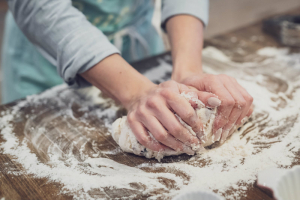Section Links
- Why is extra gluten needed in some breads?
- What happens without gluten in bread?
- What role does gluten play in cake and biscuit making?
- What role does gluten play in bread making?
- What about Oats?
- Apart from wheat, what other grains contain gluten?
- Ingredient Labelling of Wheat
- Uses of Gluten
- How is Gluten Manufactured?
To obtain gluten, flour is mixed with water and the starch is washed out. This process is completed commercially and a great deal of care is needed to maintain the baking quality of gluten.
First step: The flour and water are mixed together. The resulting dough is left to rest to allow the protein components time to absorb the water.
Second step: The dough is then conveyed into long horizontal water filled tank containing screw-type conveyors, which knead the dough until all the starch is suspended in the wash water.

Third Step: All that remains between the screws is the gluten mass which is then forced through fine openings, chopped into small pieces and dried in a hot turbulent air stream ready for bagging.
There are different strengths of commercial gluten – stronger glutens are usually a grayish green colour while weaker glutens are yellow. Commercial gluten is available as either a dried powder or in a wet form
The approximate composition of dry gluten is:
| Protein | 70-75% |
| Starch | 11-16% |
| Moisture | 8% |
| Fat | 5-8% |
| Fibre | 1% |
